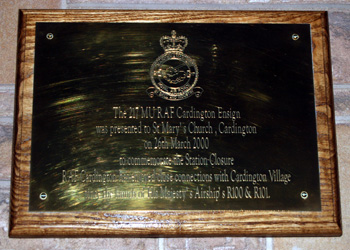
The sheds at RAF Cardington March 2011
Bedfordshire and Luton Archives and Records Service has a brief history of RAF Cardington [ref: CRT130Cardington3] put together by staff from the base itself and by the Ministry for Air about 1960.
RAF Cardington opened in 1936 and was a specialist training base for balloon operators, the first batch of recruits undergoing basic training on entry into the RAF arriving in 1937. Basic training of new recruits continued until 1953. Training of balloon operators was stepped up in 1938 to ensure the full manning of barrage balloon units around the coasts in the event of war. Following the conquest of their homelands many Polish and Dutch personnel were trained in balloon handling.
The balloon training unit closed in November 1943, by which time it had trained over five thousand RAF balloon operators and nearly the same number of operators from the Women’s Royal Air Force as well as twelve thousand other balloon personnel and drivers of both sexes. At the end of May 1945 a Personnel Dispatch Centre was set up to process personnel being demobilised.
Bedfordshire and Luton Archives and Records Service has a booklet written by retired Dutch Air Force Captain Pieter J. Huijskens in 2005, and translated by the author, called Cardington: A Pillar in the Development of the Post War Royal Netherlands Air Force. The Germans invaded the Netherlands without a declaration of war, on 10th May 1940 and the country surrendered on 15th of that month, the Dutch Air Force was largely destroyed on that ground. 220 men escaped to England via France, a further 75 men from the Navy Air Service also making it to saftey. 320 and 321 Squadrons RAF were formed from these Dutch servicemen. 322 Squadron was formed in 1943.
Towards the end of the war the Dutch government decided to look to the RAF to help rebuild the Dutch Air Force and an enlistment centre was opened at Ypenburg. Enlisted men were transferred to RAF Blankenberge on the Belgian coast. Some men then went to Australia for training, others to England and for many aircrew, the destination was RAF Cardington. They underwent a short period of basic training before being posted to Aircrew Reception Centre at Bridgnorth in Shropshire. In this way Cardington played a part in the renaissance of the Dutch Air Force
Cardington continued to be associated with balloons, No. 1 Balloon Training Unit becoming the Balloon Development Unit in August 1945 and the Balloon Unit in April 1948. In November 1945 the Balloon Development Establishment became The Research and Development Establishment.
In October 1946 No. 2 Reception Unit was established at Cardington to process all airmen recruited through National Service, voluntary enlistment and re-enlistment. On 26thMay 1952 the one hundred thousandth airman to join the RAF since the end of World War Two, Aircraftsman 2nd Class Dugmore, passed through the unit and received a silver cup in commemoration! The School of Recruitment Training closed in 1953 and the Reception Unit thus continued to receive new recruits but Cardington had no part to play in actually training them. Also in 1953 Number 134 Squadron Air Training Corps was established at Cardington and continues to occupy part of the site at the time of writing [2011].
A gas factory had been built at Cardington in the early days of the Royal Airship Works to produce hydrogen gas. This factory continued as 217 Maintenance Unit, producing hydrogen, oxygen and compressed gases as well as repairing gas cylinders. By the 1960s a number of other specialist facilities were also housed at Cardington including the Mechanical and Electrical Central Depot, Mechanical Transport Repair Centre and Airfield Testing and Concrete Soils and Bitumen Laboratories.
The RAF station began to decline in importance in the 1970s and the numbers of personnel were reduced. In 1970 No. 2 Hanger was rented from MoD by the Fire Research Station, then based at Borehamwood, Herts. and operated by the Joint Fire Research Organisation (a co-operative effort between the Fire Offices' Committee and the Government). The Building Research Establishment was formed in 1972 by an amalgamation of FRS, Building Research Station at Garston, Watford, and the Forest Products Laboratory at prices Risborough. Several years after this merger research work other than that on fire began. In 1990 the hangar was transferred to the Building Research Establishment for destruction testing of building techniques. Hangar 2 was resheeted during the late 1980s as faulty sheeting was letting in too much wind and water causing problems in carrying out experimental work. The BRE have now hired the hangar out for filming puropses.Photographs taken by John Webb, former Senior Scientific Officer FRS show the interior of hangar 2 in 1970 & 1994. Number 1 hangar is, at the time of writing [2011] in a seriously dilapidated condition. Part of the site is used by the Driving Standards Agency to train driving examiners.

Plaque commemorating the closure of RAF Cardington in 2000
RAF Cardington officially closed in 2000 and on 26th March the ensign of 217 Maintenance Unit was laid up in Cardington church with an accompanying plaque [see above]. 134 Squadron Air Training Corps continues to have its headquarters at the site. At the time of writing [2011] the former administration block is being redeveloped as flats and a new housing development, known as New Cardington, is being built on part of the site. The Meteorological Office has been associated with Cardington since the days of the Royal Airship Works and continues to have a station at the site.
A full history of the fire research Station (up to 1994) including its use of hangar 2 with pictures can be found in 'A Short History of the Fire research Station, Borehamwood by R E H Read (ISBN 0 85125 644 9).